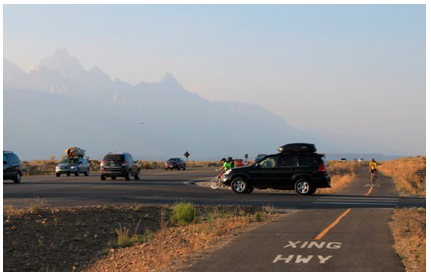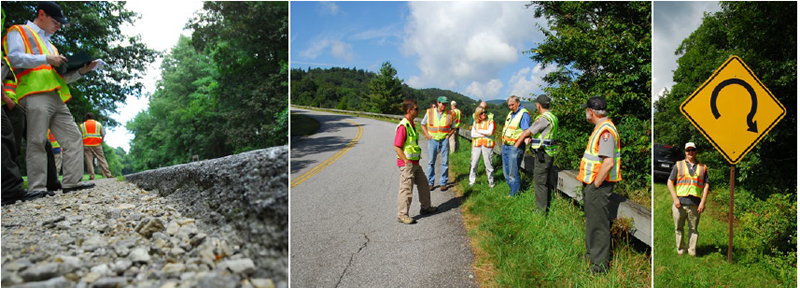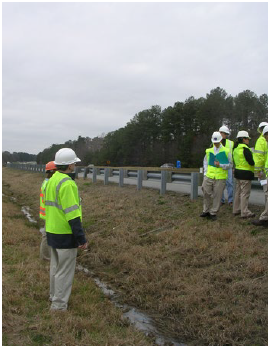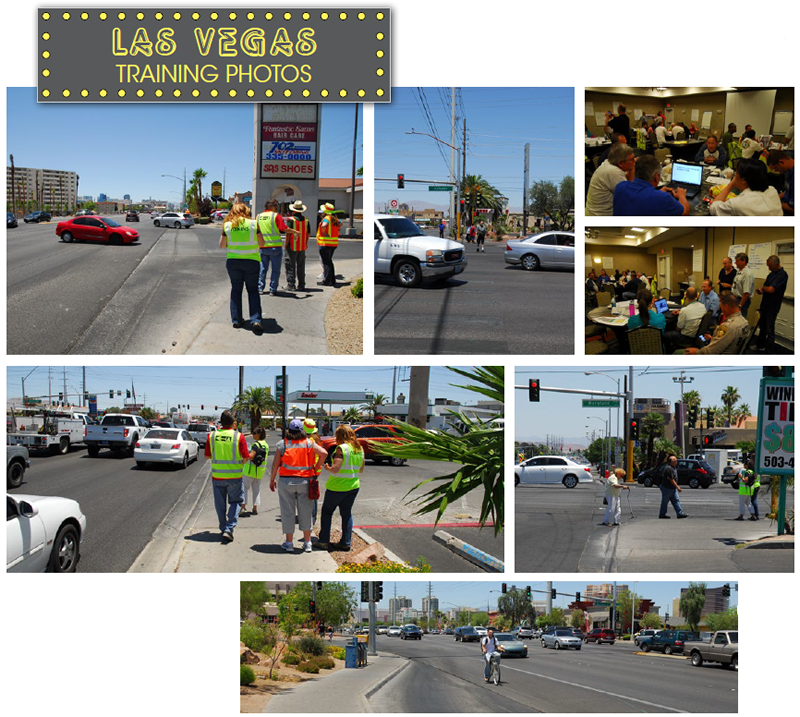U.S. Department of Transportation
Federal Highway Administration
1200 New Jersey Avenue, SE
Washington, DC 20590
202-366-4000

Best for printing: rsa_winter2013.pdf (1.2 MB)
To view PDF files, you can use the Acrobat® Reader®.
By Becky Crowe, RSA Program Manager
FHWA Office of Safety
Happy New Year. It's been an incredibly busy few months since our last newsletter. The Bicycle RSA Guidelines have been finalized and released and we've started a brand new pilot project to assist five (5) Tribal and Federal Land Management Agencies with establishing RSA Programs.
As you have surely heard, MAP-21, the Moving Ahead for Progress in the 21st Century Act, was signed into law by President Obama on July 6, 2012. MAP-21 supports USDOT's aggressive safety agenda and I'm happy to report that RSAs are mentioned in the Highway Safety Improvement Program under Updates to Strategic Highway Safety Plans.
Moving Ahead for Progress in the 21st Century (MAP-21) ActSec. 1112, 23 U.S.C. 148, Highway safety improvement program UPDATES TO STRATEGIC HIGHWAY SAFETY PLANS.– " (1) ESTABLISHMENT OF REQUIREMENTS.–" (A) IN GENERAL.–Not later than 1 year after the date of enactment of the MAP-21, the Secretary shall establish requirements for regularly recurring State updates of strategic highway safety plans. " (B) CONTENTS OF UPDATED STRATEGIC HIGHWAY SAFETY PLANS.–In establishing requirements under this subsection, the Secretary shall ensure that States take into consideration, with respect to updated strategic highway safety plans– "(i) the findings of road safety audits;..." |
I hope you enjoy this issue of the RSA Newsletter and I would love to know how RSAs are being used to improve safety on your roads. Please keep in touch!

|
For more information, please
visit: http://safety.fhwa.dot.gov/rsa |
By Elissa Goughnour, VHB
 The crossing of a newly constructed shared use path near the intersection of Gros Ventre Road and Highway 89 in the Grand Teton National Park. IMAGE COURTESY of Elissa Goughnour, VHB. |
In September 2012, the Grand Teton National Park staff along with individuals from the National Park Service Intermountain Regional Office, the Wyoming Department of Transportation, the Federal Highway Administration (FHWA) and Western Federal Lands Highway Division, conducted a Bicycle Road Safety Audit (BRSA) to assess the safety of a bicycle crossing near the Gros Ventre Intersection. The team was comprised of individuals with a variety of backgrounds including law enforcement, engineering, environmental, and landscape architecture. The recently published FHWA Bicycle RSA guidelines have been used to conduct Bicycle RSAs in Atlanta, Georgia, on the George Washington Memorial Parkway, and now in the Grand Teton National Park. The three day RSA process was used to review the behavior, needs, and facilities of all modes of transportation but focused on the interaction of cyclists on a newly constructed shared use path.
The RSA was conducted at the intersection of Gros Ventre Road and US Highway 26/89/191 and included the crossing of a newly constructed shared use path to the east of the roadway intersection. Construction of this approximately six and a half mile portion of pathway was completed in the summer of 2012. It completes a 12.5 mile stretch that travels from Jackson to Moose Junction, and is part of an over 20 mile stretch that travels from Jackson to Jenny Lake. Users of the Gros Ventre intersection have witnessed many near misses between cyclists and motor vehicles. The Grand Teton National Park requested an RSA in response to these concerns. Some of the positive features observed by the RSA team included the shared use path, which provides cyclists, pedestrians, and other non-motorized users a space that is separated from the high speed, high-volume motorized vehicle traffic on US 26/89/191. Other positive features include the pavement markings and signage along the shared use path and the surrounding intersection roadways. The existing markings and signage help to inform and alert drivers of the location of the path crossing and they warn path users of the upcoming roadway crossing.
While the shared use path provides cyclists, pedestrians, and other non-motorized user's space separated from the high-speed, high-volume motorized vehicle traffic on US 26/89/191, there are certain challenges at the intersections of the roadway and path that were assessed by the RSA team. To address these challenges the team developed short-range, intermediate, and long-range preliminary suggestions. Short-range improvements included increased signage and pavement markings for both the roadways and the shared use path along with methods to help slow traffic down prior to the intersection. Intermediate and long range improvements included suggestions such as relocating the shared use path crossing, using a variety of tunnel configurations, and construction of a roundabout. Many of the suggestions provide safety benefits for non-motorized users, but also work for motor vehicles and for local wildlife.
As the park continues to promote non-motorized travel, BRSAs will be an invaluable tool to proactively evaluate and address safety concerns.
For more information about the Grand Teton RSA, please contact:
|
Kathy Sugnet, PE CFM |
Jon L. Christensen, Landscape
Architect |
As the implementation of RSAs continues to spread across the country, Federal Land Management Agencies (FLMAs) and Tribal governments are also beginning to witness the benefits of conducting RSAs. Just like State and local agencies, they often face identical resource challenges, such as staffing and funding constraints. However, Tribes and other Federal Land Management Agencies have unique conditions that must be considered when applying the RSA process. As a result, the FHWA Office of Safety is sponsoring five (5) pilot projects with various Tribal and Federal Land Management Agencies to introduce RSAs as a permanent, sustainable program that will result in transportation safety improvements for all users.
 Blue Ridge Parkway RSA images. IMAGES COURTESY of Dan Nabors, VHB. |
FHWA is conducting the pilots with the Bureau of Indian Affairs (BIA) Rocky Mountain Region, the Blue Ridge Parkway, the Confederated Tribes of the Coleville Reservation, the Pueblo of Isleta, and the Willamette National Forest. These FLMAs and Tribes were selected based upon their application outlining safety challenges, their ability to participate in the pilot and to sustain an RSA program, as well as their level of support from other organizations.
To date, RSA training and pilot RSAs have been conducted with the Blue Ridge Parkway, the BIA Rocky Mountain Region, and the Willamette National Forest. Mr. Andy Otten, Project Specialist with the National Park Service, stated that "the training helped us understand the RSA process and provided guidance in the initial steps of identifying and understanding some of the systemic and hot spot safety issues we face here at the Blue Ridge Parkway.
Over the next year, FHWA will work with the FLMAs and Tribes to create a sustainable RSA program. The effort will include performing RSAs as well as providing training and technical assistance to the participating agencies. The goal of the pilots is to provide meaningful examples to all FLMAs and Tribal governments on the benefits of RSAs and to help them promote the program within their own organizations.
|
For more information about the Tribal/ FLMA RSA Pilot Program, contact Becky Crowe, FHWA, at rebecca.crowe@dot.gov |
Earlier this year, the Virginia DOT performed a unique Road Safety Assessment in Emporia, Virginia. The goal of the RSA was to identify potential safety issues and recommend countermeasures related to the construction and operational use of a salt containment site in the Interstate Right of Way (ROW). The RSA was conducted at Exit 13 on northbound I-95 on Friday, March 2, 2012 and included VDOT personnel representing Interstate maintenance, facility management, and safety. The FHWA Virginia Division office also participated as well as human factors and traffic control device experts.
|
"When we first considered using Interstate Right-of-Way for a salt containment site, we knew we would have to take steps to ensure motorist safety. The RSA helped us identify the variety of factors that might create driver confusion or distraction from site operations, which led to a series of recommendations to proactively mitigate those issues and prevent potential crashes." — Robert Weber, Virginia DOT Traffic Studies & Safety Engineer |
 Photo Rendering of Proposed Canopy on Existing Site. IMAGE COURTESY of FHWA. |
 Emporia RSA team in action. IMAGE COURTESY of FHWA. |
VDOT was preparing to acquire a salt containment shelter from Fort Monroe, which is a military base scheduled for closure. VDOT therefore had to identify a location that was already owned by the Department or otherwise readily available. The infield area of the southeast quadrant of Exit 13 on I-95 was identified as a possible site for the following reasons.
An analysis of crashes between 2006 and 2010 showed that there were 16 crashes on the mainline of I-95 in the vicinity of Exit 13. A majority of the crashes occurred on the southbound side in clear, daylight conditions. A majority of crashes were classified as fixed object-off road types of collisions. Of the 16 total crashes, two occurred on the northbound side. One was a deer strike near the gore area of Exit 13. The other crash was the result of a driver who fell asleep and ran off the road. In addition to the two crashes on the mainline of I-95 northbound, there was also an angular crash at the top of the ramp from I-95 North where it intersects with Route 614.
Prior to the RSA, photo renderings of the salt containment shelter were created to depict how the structure would look at the site. RSA team members reviewed these photo renderings during a start-up meeting to become familiar with the dimensions of the shelter and its proposed placement. The team took the renderings with them for the field review to help visualize how the shelter would appear to drivers and the potential impacts it would have on safety.
During the field review, the RSA team reviewed the proposed site in the southeast quadrant of the interchange as well as a possible alternative location in the northeast quadrant. The RSA team identified potential safety issues that could result from the construction and operation of the salt containment site and identified several countermeasures to mitigate driver distraction, driver confusion, wrong way movements, and poor sight distance. The group also identified improvements at the intersection with the exit ramp and State Secondary Route 614 that could better accommodate trucks bound for both directions of I-95.
After reviewing both quadrants, the RSA team recommended the southeast quadrant as the safer location for the salt containment site. The safety concerns at this location can be more easily mitigated with the recommended countermeasures and require less site work to prepare for construction and operation.
For more information about the Emporia, Virginia RSA, please contact:
Bill Collier, Interstate Maintenance Mgr.
Virginia DOT
w.collier@vdot.virginia.gov
Jose Granado, Area Engineer
FHWA-Virginia Division Office
jose.granado@dot.gov
NEW Bicycle RSA (BRSA) GuidelinesThe Bicycle Road Safety Audit Guidelines and Prompt Lists are now available for download on the FHWA Safety website at http://safety.fhwa.dot.gov/ped_bike/tools_solve/fhwasa12018/. This newest RSA publication provides transportation agencies and RSA teams with a better understanding of the safety of cyclists in the transportation system. The Guidelines present the RSA team with an overview of basic principles of the safety of cyclists and the potential issues affecting them. The publication also provides information on how to perform an RSA and effectively assess the safety of cyclists. Prompt lists are included with the guidelines and highlight safety issues that should be considered when conducting a cyclist-specific RSA. These Guidelines will help RSA teams evaluate and suggest a multimodal approach to safety by improving the safety of cyclists and all roadway users. For more information regarding the use of BRSAs in your State, region, or community, contact Becky Crowe, FHWA, at rebecca.crowe@dot.gov |
Jaime Tuddao, Nevada DOT Senior Safety Engineer, requested the training workshop and says, "Nevada is a Zero Fatalities Goal State and we use RSAs as much as possible to help us with achieving that goal. The RSA training that Craig provided increased our knowledge in the field of safety engineering and we now have an even bigger pool of people who are prepared to serve in the capacity of an RSA team leader." |

The Mo-Kan Regional Council partnered with the Missouri DOT and the Missouri State Highway Patrol to perform an RSA several miles south of St. Joseph at the intersection of US- 169 and MO-31. The intersection has a high percentage of truck traffic. A main concern is sight distance as trucks travel downhill on MO-31. The team worked to address these and other concerns at the intersection. The RSA received local media coverage, which can be viewed online.
The Nevada DOT (NDOT) performed a pre-opening RSA on I-580, a new freeway that opened in August and connects Reno and Carson City. This was the first RSA that NDOT performed on a ready-to-open facility and one of the RSA recommendations was to install rumble stripes.
The American Traffic Safety Services Association (ATSSA), National Organizations for Youth Safety (NOYS), and the Roadway Safety Foundation (RSF) have partnered to start a new program called Teen Roadway Safety Assessments (TeenRSATM). With the support of local transportation professionals, teens work together to identify potential problem areas in their communities and learn the fundamentals of roadway safety and design. They then apply these skills in the field where they discover first-hand the many dangers that exist in and around the roadway. They also learn ways to improve their surroundings, including better signage, roadway striping, or simply cutting back vegetation to improve visibility. The program will officially "roll out" nationally in the spring of 2013 following several pilot projects. The national program is seeking interested partners and sponsors. To learn more, please contact ATSSA at (540) 368-1701.
The new FHWA Center for Accelerating Innovation (which supports Every Day Counts and Highways for LIFE) highlighted RSAs in their latest newsletter. The article is online at https://www.fhwa.dot.gov/hfl/innovator/pdfs/issue31.pdf.
Below is a map showing the status of RSAs across the US. Do you have other information on RSAs to report for your state? Please let us know!

|
To highlight your agency's RSA in the
newsletter or to learn about upcoming RSA training activities
contact: Heather Rigdon Heather.Rigdon.ctr@dot.gov
For more information on the Road Safety Audit Peer Assistance
Program email: safetyP2P@dot.gov
or call: (866) P2P-FHWA |
| The FHWA Office of Safety's mission is to reduce highway fatalities by making our roads safer through a data-driven, systematic approach and addressing all "4Es" of safety: engineering, education, enforcement, and emergency medical services. Increasing awareness of the need for roadway safety infrastructure improvements is very important. We are striving to provide decision-makers with important information, tools and resources that will improve the safety performance of roadways. Safety should be considered first, every time and at every stage of a project. Make safety your first consideration in every investment decision. |
